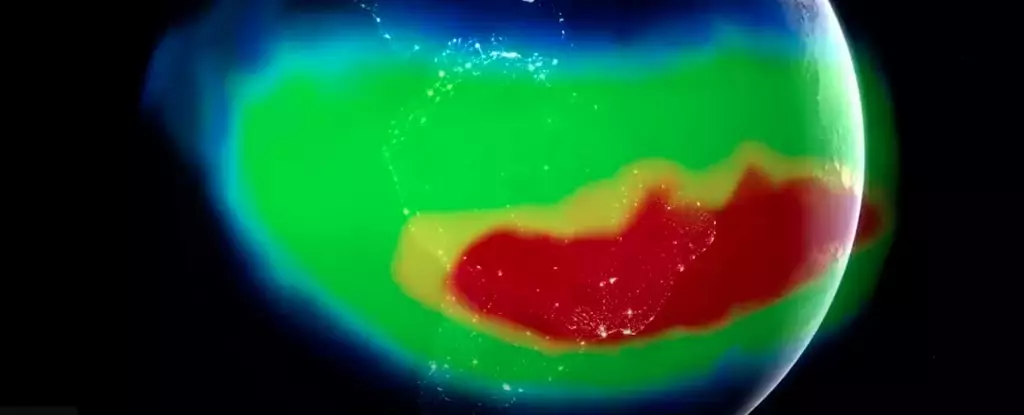At the interface of geology and technology lies the South Atlantic Anomaly (SAA)—a perplexing irregularity in Earth’s magnetic field that spans a vast area from South America to southwest Africa. Despite its distance from human activity, the implications of this anomaly extend into the realm of our technological dependability in space. Given that many satellites, including the International Space Station, traverse this zone, the weakened magnetic field presents significant hazards for space operations, risking the integrity of these vital systems.
NASA, standing at the forefront of space exploration, has diligently monitored this phenomenon as it impacts the delicate balance of the satellite communications and navigational systems that countless people rely on each day. The SAA is often visually represented as a ‘dent’ or a ‘pothole in space,’ reflecting a tangible vulnerability in an otherwise robust magnetic shield that protects Earth from solar radiation and cosmic rays. Such vulnerabilities become critical points of study for researchers who seek to mitigate risks posed by interactions with high-energy particles emanating from the Sun.
The Dance of the Earth’s Magnetic Field
The earth’s magnetic field is the byproduct of complex geophysical processes occurring deep within the planet. The primary generator of this magnetic shield is a swirling mass of molten iron situated in the outer core, around 2,900 kilometers beneath the Earth’s crust. As this molten iron flows, it creates electrical currents that give rise to magnetic forces. The intriguing aspect of the SAA is the uneven nature of this magnetic generation, which has catapulted it into a unique category worthy of scientific scrutiny.
Factors such as the African Large Low Shear Velocity Province—a mass of dense rock beneath Africa—intrude upon this magnetic process, resulting in a marked reduction in the magnetic field strength over the SAA. Research suggests that this area experiences a localized magnetic field with reversed polarity, contributing to its anomalously low intensity. By understanding the complex interplay of these geological structures, researchers hope to gain clarity on how such discrepancies influence spacecraft operations and, potentially, our understanding of Earth’s magnetic history.
A Shifting Landscape
The SAA is not a static entity; rather, it exhibits a peculiar dynamism that marks a significant aspect of its ongoing evolution. Research spearheaded by NASA has confirmed that the SAA is gradually drifting over time, a phenomenon that has been observed by CubeSats in various studies, underscoring the importance of continued monitoring. One of the most startling findings is that the SAA appears to be on the verge of bifurcation, indicating it may soon form two distinct cells of low magnetic intensity.
The implications of a split SAA are monumental. Understanding its trajectory not only feeds into knowledge of the magnetic field’s history but also raises questions about its potential future behaviors. While some scientists have speculated that the SAA could be a signaling precursor to a complete geomagnetic reversal—a natural event that takes place over geological timescales—recent findings indicate that the anomaly is part of a longer-term pattern which may have been present for millions of years.
Scientific Curiosity and Technological Resilience
As we continue to deepen our understanding of the South Atlantic Anomaly, we find ourselves at an intersection of scientific curiosity and technological resilience. Each study and observation contributes to a broader comprehension of Earth’s magnetic field, offering insights that may lead to advanced measures for protecting satellites against the potentially debilitating effects of the anomaly.
NASA’s relentless pursuit of knowledge about the SAA exemplifies a much larger commitment to addressing the intricate challenges posed by our planet’s physical behaviors. By engaging in active monitoring and exploration of this mysterious magnetic realm, researchers are interpreting complex data to equip us better for future challenges in space and technology.
More than just a geographical curiosity, the South Atlantic Anomaly represents the interplay between Earth’s natural phenomena and human innovation in the face of uncertainty. While many aspects of the SAA remain shrouded in mystery, one thing is clear: the commitment to understanding and addressing its impacts will only grow stronger as technology continues to advance. The unfolding narrative surrounding this anomaly will likely yield critical insights into our planet and its magnetic behavior, reminding us that even amidst the shadows of the unknown, science holds the key to illumination.

